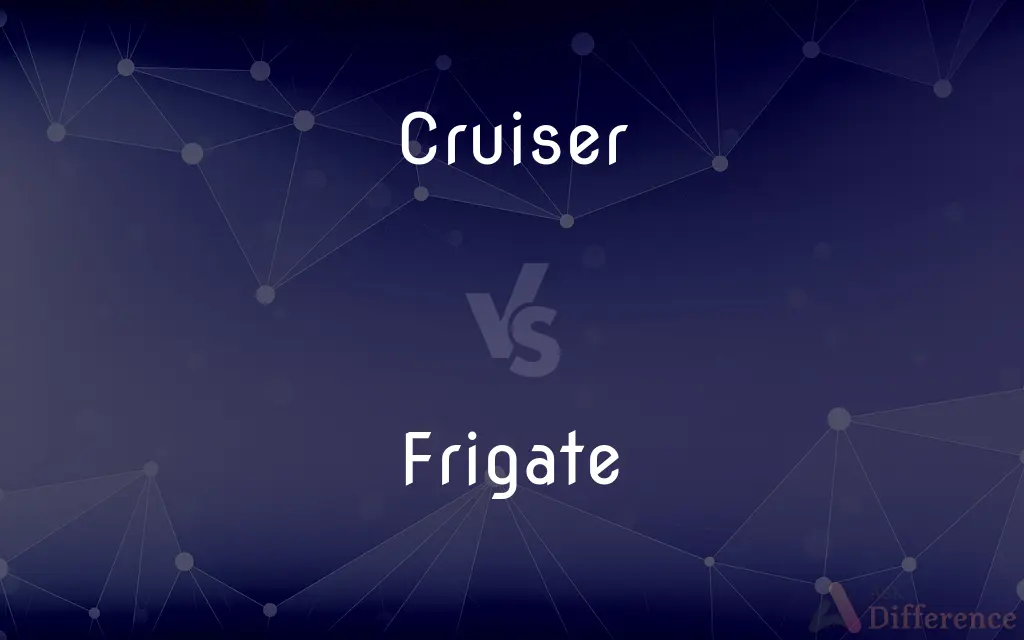Cruiser vs. Frigate — What's the Difference?
Edited by Tayyaba Rehman — By Maham Liaqat — Updated on April 15, 2024
Cruisers are larger, heavily armed naval vessels optimized for fleet air defense and surface combat, whereas frigates are smaller, versatile ships used mainly for anti-submarine warfare and escort missions.

Difference Between Cruiser and Frigate
Table of Contents
ADVERTISEMENT
Key Differences
Cruisers are designed for sustained operations and carry significant firepower including missiles and guns, making them suitable for engaging multiple threats simultaneously. Frigates, on the other hand, are generally lighter and faster, optimized for specific tasks like hunting submarines or guarding other vessels.
Cruisers often operate as part of larger naval task forces, providing air defense and command capabilities. Frigates, whereas, typically serve in a more supportive role, offering protection and patrol functions within a naval fleet.
Due to their size, cruisers have more extensive electronic warfare and radar systems, which enable them to perform wide-area surveillance. Frigates maintain a focus on anti-submarine and surface warfare systems, prioritizing agility over comprehensive electronic capabilities.
Cruisers require larger crews to manage their complex weapon systems and technologies. Frigates are manned by smaller crews, reflecting their more focused operational roles and simpler systems.
Despite their differences, both cruisers and frigates are integral to modern naval strategy, complementing each other's capabilities in joint operations and task groups.
ADVERTISEMENT
Comparison Chart
Size
Larger and heavily built
Smaller and more maneuverable
Primary Role
Air defense and surface combat
Anti-submarine warfare and escort missions
Firepower
High; equipped with advanced missile systems
Moderate; specialized in anti-submarine torpedoes
Radar and Electronics
Advanced, capable of fleet-wide coordination
Focused mainly on specific threat detection
Crew Size
Larger crew required
Smaller crew, reflecting simpler operations
Compare with Definitions
Cruiser
Naval vessel designed for high endurance tasks.
The cruiser remained at sea for extended patrols.
Frigate
Often used for escort duties within a naval fleet.
The frigate escorted the aircraft carrier through the strait.
Cruiser
Requires a large crew for its complex systems.
The cruiser’s crew efficiency was tested during the high seas maneuver.
Frigate
A warship with specialized anti-submarine capabilities.
The frigate deployed its sonar to detect underwater threats.
Cruiser
A large warship capable of engaging multiple threats.
The cruiser positioned itself as the central command ship in the fleet.
Frigate
Requires a smaller crew, focused on specific roles.
The frigate’s crew practiced rapid-response tactics.
Cruiser
Ship equipped with powerful anti-air and missile defense systems.
During the exercise, the cruiser demonstrated its missile defense capabilities.
Frigate
Equipped for surface warfare and patrol missions.
The frigate engaged pirate vessels near the coast.
Cruiser
Operates often as part of significant naval operations.
The cruiser led the maritime strike group during the operation.
Frigate
Smaller than a cruiser, designed for speed and agility.
The frigate maneuvered quickly to position itself between the threat and the convoy.
Cruiser
A cruiser is a type of warship. Modern cruisers are generally the largest ships in a fleet after aircraft carriers and amphibious assault ships, and can usually perform several roles.
Frigate
A frigate () is a type of warship. In different eras, ships classified as frigates have had very varied roles and capabilities.
Cruiser
One of a class of fast warships of medium tonnage with a long cruising radius and less armor and firepower than a battleship.
Frigate
A warship that is smaller than a destroyer and used primarily for escort duty.
Cruiser
A cabin cruiser.
Frigate
A high-speed, medium-sized sailing war vessel of the 1600s, 1700s, and 1800s.
Cruiser
See squad car.
Frigate
(Obsolete) A fast, light vessel, such as a sailboat.
Cruiser
One who attends cruises.
Frigate
(nautical) Any of several types of warship:
Cruiser
(cycling) A kind of bicycle that usually combines balloon tires, an upright seating posture, a single-speed drivetrain, and straightforward steel construction with expressive styling.
Frigate
(historical) A sailing warship (of any size) built for speed and maneuverability; typically without raised upperworks, having a flush forecastle and tumblehome sides.
Cruiser
A frigate or other vessel, detached from the fleet, to cruise independently in search of the enemy or its merchant ships.
Frigate
(historical) A sailing warship with a single continuous gun deck, typically used for patrolling and blockading duties, but not considered large enough for the line of battle.
Cruiser
(nautical) A class of fast warships of medium tonnage, having a long cruising range but less armour and firepower than a battleship.
Frigate
(historical) A warship combining sail and steam propulsion, typically of ironclad timber construction, supplementing and superseding sailing ships of the line at the beginning of the development of the ironclad battleship.
Cruiser
(nautical) A miniature aircraft carrier carrying VTOL aircraft.
Frigate
(historical) A escort warship, smaller than a destroyer, introduced in World War 2 as an anti-submarine vessel.
Cruiser
(nautical) A passenger ship used for pleasure voyages, where the voyage itself and the ship's amenities are considered an essential part of the experience.
Frigate
A modern type of warship, equivalent in size or smaller than a destroyer, often focused on anti-submarine warfare, but sometimes general purpose.
Cruiser
(nautical) Any of several yachts designed for cruising.
Frigate
(fictional) A warship or space warship, inspired by one of the many historic varieties of frigate.
Cruiser
A police patrol vehicle.
Frigate
A frigatebird (Fregata spp.).
Cruiser
(entomology) Any of various nymphalid butterflies of the genus Vindula.
Frigate
Originally, a vessel of the Mediterranean propelled by sails and by oars. The French, about 1650, transferred the name to larger vessels, and by 1750 it had been appropriated for a class of war vessels intermediate between corvettes and ships of the line. Frigates, from about 1750 to 1850, had one full battery deck and, often, a spar deck with a lighter battery. They carried sometimes as many as fifty guns. After the application of steam to navigation steam frigates of largely increased size and power were built, and formed the main part of the navies of the world till about 1870, when the introduction of ironclads superseded them.
Cruiser
(entomology) Any dragonfly of the family Macromiidae; a macromiid.
Frigate
Any small vessel on the water.
Cruiser
Someone who cruises bars and neighborhoods looking for "action".
Frigate
A medium size square-rigged warship of the 18th and 19th centuries
Cruiser
One who, or a vessel that, cruises;
Frigate
A United States warship larger than a destroyer and smaller than a cruiser
Cruiser
A car in which policemen cruise the streets; equipped with radiotelephonic communications to headquarters
Cruiser
A large fast warship; smaller than a battleship and larger than a destroyer
Cruiser
A large motorboat that has a cabin and plumbing and other conveniences necessary for living on board
Common Curiosities
How do cruisers support other vessels in a fleet?
Cruisers provide air defense and serve as command ships, coordinating operations among other vessels.
How do frigates contribute to naval missions?
Frigates primarily conduct anti-submarine warfare and provide escort services.
What are the key differences in the armament between cruisers and frigates?
Cruisers are equipped with a broader array of weapons, including advanced missile systems, while frigates focus on torpedoes and anti-submarine gear.
What type of warfare systems are cruisers equipped with?
Cruisers are equipped with advanced radar, missiles, and anti-air systems.
Can frigates operate independently?
Yes, frigates can operate independently but are often more effective within a task force or fleet.
What makes frigates agile and fast in naval operations?
Frigates are designed for speed and maneuverability, enabling them to work more conveniently.
What is the primary function of a cruiser?
Cruisers are primarily used for fleet air defense and surface combat operations.
Why are cruisers considered versatile in naval warfare?
Due to their size and extensive capabilities, cruisers can engage multiple threats and coordinate fleet actions.
How does the crew size differ between cruisers and frigates?
Cruisers have larger crews to manage more complex systems, whereas frigates require fewer personnel.
In what type of missions are frigates most valuable?
Frigates are most valuable in anti-submarine and patrol missions.
Share Your Discovery

Previous Comparison
Pub vs. Cafe
Next Comparison
Companion vs. PartnerAuthor Spotlight
Written by
Maham LiaqatEdited by
Tayyaba RehmanTayyaba Rehman is a distinguished writer, currently serving as a primary contributor to askdifference.com. As a researcher in semantics and etymology, Tayyaba's passion for the complexity of languages and their distinctions has found a perfect home on the platform. Tayyaba delves into the intricacies of language, distinguishing between commonly confused words and phrases, thereby providing clarity for readers worldwide.













































